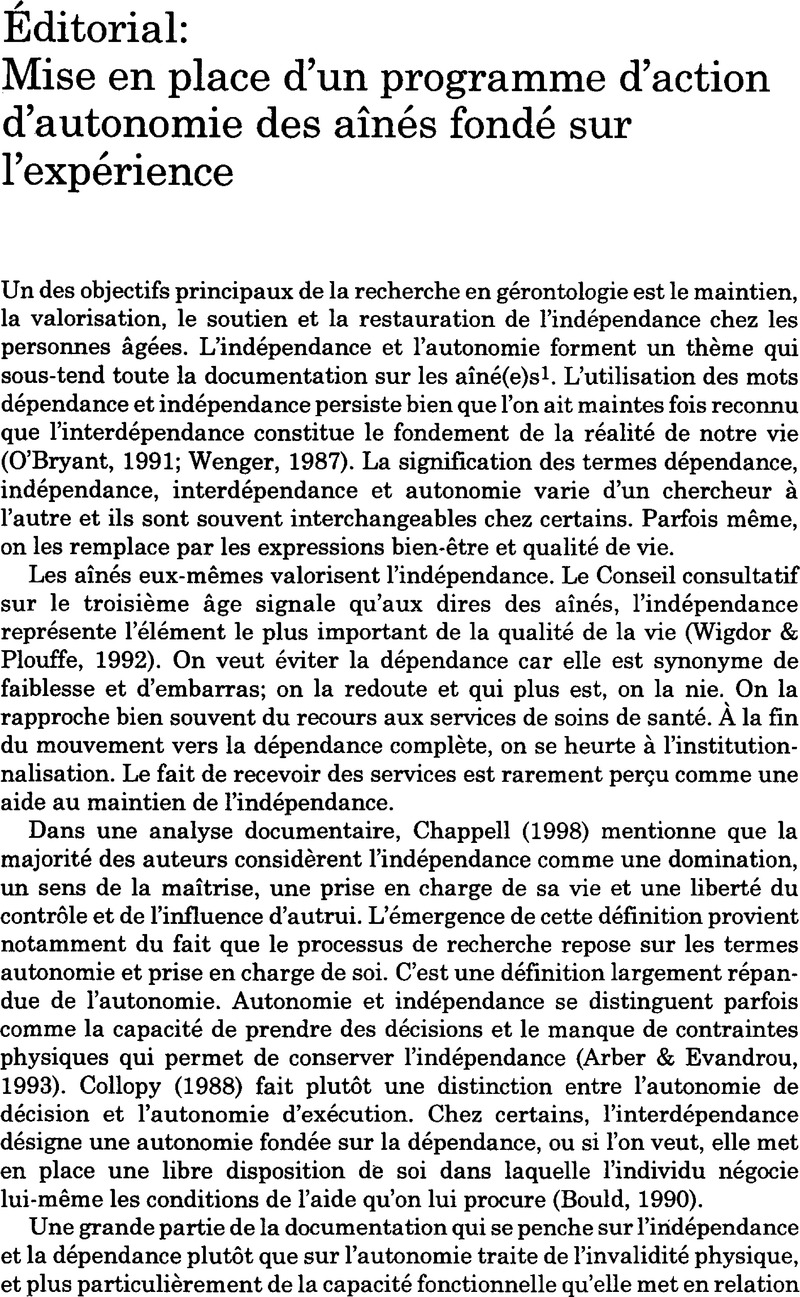No CrossRef data available.
Article contents
Éditorial: Mise en place d'un programme d'action d'autonomie des aînes fondé sur l'expérience
Published online by Cambridge University Press: 29 November 2010
Abstract
An abstract is not available for this content so a preview has been provided. As you have access to this content, a full PDF is available via the ‘Save PDF’ action button.

- Type
- Editorial/Éditorial
- Information
- Canadian Journal on Aging / La Revue canadienne du vieillissement , Volume 19 , Issue S1 , Summer/Été 2000 , pp. vi - x
- Copyright
- Copyright © Canadian Association on Gerontology 2000
References
Références
Agich, G. (1990). Reassessing autonomy in long-term care. Hastings Center Report (Nov/Dec), 12–17.CrossRefGoogle Scholar
Arber, S., & Evandrou, M. (1993). Mapping the territory: Ageing, independence and the life course. Arber, Dans S. & Evandrou, M. (Eds.), Ageing, independence and the life course. London: Jessica Kingsley Publishers.Google Scholar
Bould, S. (1990). The oldest old: Caregiving or social support? Prevention in Human Services, 9(1), 235–251.CrossRefGoogle Scholar
Branch, L.G., & Ku, L. (1989). Transition probabilities to dependency, institutionalization, and death among the elderly over a decade. Journal of Aging and Health, 2(3), 370–408.CrossRefGoogle Scholar
Chappell, N.L. (1998). Conceptual Aspects of Independence: What are the Policy, Programming, Practice and Research Implications? Final Report. Systematic Literature Review and Synthesis National Consensus Process: Creating Evidence-Based Consensus on Health, Social, & Economic Issues Related to Seniors' Independence. Centre on Aging, University of Victoria, BC.Google Scholar
Chipperfield, J.G. (1996). Perceived adequacy of instrumental assistance: Implications for well-being in later life. Journal of Aging and Health, 8(1), 72–95.CrossRefGoogle ScholarPubMed
Collopy, B.J. (1988). Autonomy in long term care: Some crucial distinctions. The Gerontologist, 28(suppl.).CrossRefGoogle ScholarPubMed
Gignac, M.A.M., & Cott, C. (1998). A conceptual model of independence and dependence for adults with chronic physical illness and disability. Social Science and Medicine, 47(6), 739–753.CrossRefGoogle ScholarPubMed
Horowitz, A., Silverstone, B.M., & Reinhardt, J.P. (1991). A conceptual and empirical exploration of personal autonomy issues within family caregiving relationships. The Gerontologist, 31(1), 23–31.CrossRefGoogle ScholarPubMed
O'Bryant, S. (1991). Older widows and independent lifestyles. International Journal of Aging and Human Development, 32(1), 41–51.CrossRefGoogle ScholarPubMed
Wenger, C.G. (1987). Dependence, interdependence and reciprocity after eighty. Journal of Aging Studies, 1(4), 355–377.CrossRefGoogle ScholarPubMed
Wigdor, B.T., & Plouffe, L. (1992). Seniors' independence: Whose responsibility? National Advisory Council on Aging, Forum Collection Cat. No. H71–2/3–3– 1992. Ottawa: Minister of Supply and Services.Google Scholar




